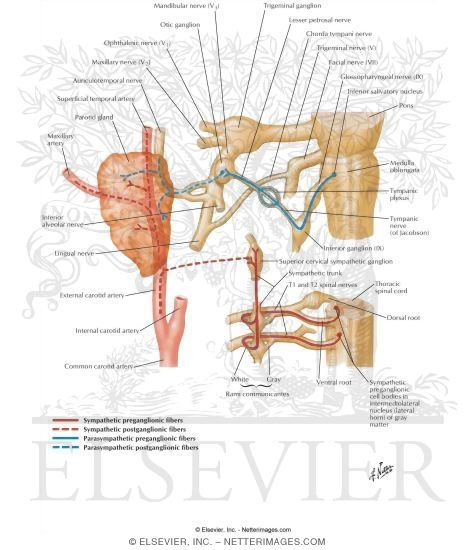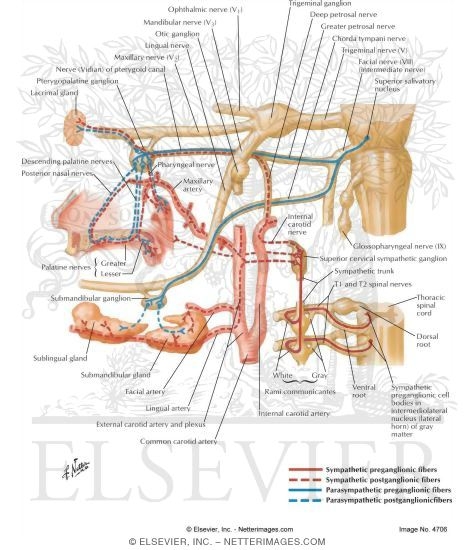OTIC GANGLION:
* It is the peripheral parasympathetic ganglion which relay its secretomotor fibres to the parotid ganglion.
* Topographically it is related to mandibular nerve but functionally it is a part of glossopharyngeal nerve.
* It has 4 roots
1) motor or parasympathetic root
2) sensory root
3) sympathetic root and
4) nerve to medial pterygoid.

only the motor or parasympathetic root relays in the ganglion.
MOTOR ROOT:
INFERIOR SALIVATORY NUCLEUS

GLOSSOPHARYGEAL NERVE

ITS TYMPHANIC BRANCH

TYMPHANIC PLEXUS

PASSES THROUGH FORAMEN OVALE

LESSER PETROSAL NERVE

OTIC GANGLION. RELAY OCCURS.

POST GANGLIONIC FIBRES PASS THRROUGH AURICULO TEMORAL NERVE

PAROTID GLAND.
SYMPATHETIC ROOT:
It is formed by plexux around middle meningeal artery. Post ganglionic fibres arise in the superior cervical ganglion, pass through the ganglion without relaying and reach the paroyid gland via the auriculo temporal nerve.
SENSORY ROOT:
It comes from the auriculo temporal nerve.
NERVE TO MEDIAL PTERYGOID:
It is a branch from mandibular nerve which passes throuh the ganglion and supplies the tensor veli tymhani and tensor veli palatini.
CHORDA TYMPHANI NERVE:
The branch from facial nerve passes through the ganglion without relaying.
SUBMANDIBULAR GANGLION:
* It is the peripheral parasympathetic ganglion which relay its secretomotor fibres to the submandibular and sublingual salivary gland
* Topographically it is related to lingual nerve but functionally related to chorda tymphani branch of facial nerve.
* It has 3 roots
1) motor or parasympathetic root
2) sensory root
3) sympathetic root

only the motor or parasympathetic root relays in the ganglion.
MOTOR ROOT:
SUPERIOR SALIVATORY NUCLEUS

FACIAL NERVE

CHORDA TYMPHANI BRANCH

JOINS WITH THE LINGUAL NERVE

REACHES THE SUBMANDIBULAR GANGLION. RELAY OCCURS

POST GANGLIONIC FIBRES SUPPLY SUBMANDIBULAR, SUBLINGUAL AND ANTERIOR LINGUAL GLANDS.
SYMPATHETIC ROOT:
It is formed by plexus around the facial artery . Post ganglionic fibres arise in the superior cervical ganglion, pass through the ganglion without relaying and reach the submandibular and sublingual gland.
SENSORY ROOT:
It reaches through the lingual nerve.
PTERYGOPALATINE GANGLION:
* It is also called HAY FEVER ganglion(Allergic sinusitis)
* It is the peripheral parasympathetic ganglion which relay its secretomotor fibres to the lacrymal gland, mucous gland of the nose,paranasal sinus,palat and pharynx
* Topographically it is related to maxillary nerve but functionally related to greater petrosal branch of facial nerve.
* It has 3 roots
1) motor or parasympathetic root
2) sensory root
3) sympathetic root

only the motor or parasympathetic root relays in the ganglion.
MOTOR ROOT:
SUPERIOR SALIVATORY AND LACRYMATORY NUCLEUS

NERVUS INTERMEDIUS

FACIAL NERVE

GENICULATE GANGLION

GREATER PETROSAL NERVE AND NERVE OF PTERYGOID CANAL

PTERYGO PALATINE GANGLION. RELAY OCCURS.

POST GANGLIONICX FIBRES PASS THROUGH ZYGOMATIC NERVE

ZYGOMATICO TEMPORAL NERVE

UNITES WITH THE LACRYMAL NERVE TO REACH THE LACRYMAL GLAND
SYMPATHETIC ROOT:
It is formed by nerve of pterygoid canal. Post ganglionic fibres arise in the superior cervical ganglion, pass through the ganglion without relaying and reach the pterygo palatine ganglion through internal carotid plexus , deep petrosal nerve and nerve of pterygoid canal.
SENSORY ROOT
It comes from maxillary nerve.
BRANCHES:
1. Orbital branch - supply periosteum of orbit and orbitlis muscle
2. Palatine branch- includes greater or anterior palatine which supplies hot palate , lateral wall of nose and lesser or middle and posterior palatine nerve supplying soft palate and tonsils
3. Nasal branch- lateral posterior superior nasal nerve supplies superior and middle concha. Medial posterior superior nasal nerve supplies posterior part of roof of the nose and nasal septum.
4. Pharyngeal branch- supplies nasopharynx.
5. Lacrymal branch- supplies lacrymal gland.